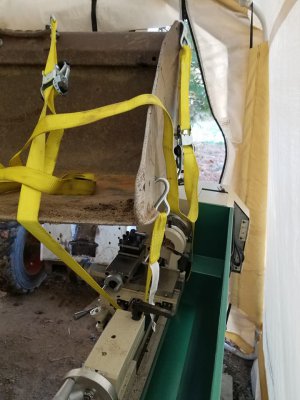- Joined
- Mar 2, 2018
- Messages
- 232
I use the tailstock on my g0602 constantly, and it has been driving me nuts for the longest time.
One of the more common things people do is just leave a 17mm wrench on the tailstock at all times. I've read lots of posts in various places, talking about how "it only takes half a turn" to snug the thing down.
Yeah, not so much. The casting for the bed on my particular lathe is machined quite satisfactorily on the top surface, but the bottom surface is just some raw, ragged nonsense. Imagine taking a cast iron surface plate and bashing it against a hard edge at a weird angle until one end of it finally snaps off.
If I start with the tailstock snugged down at the far right, and start moving toward the left, here's how it goes: Loosen about 1/2 a turn, I'm good to slide for some distance. Thunk. The clampy thing on the bottom has now collided with the ragged edge on the bottom. To get over the hump, I have to loosen the nut, maybe half, maybe a whole turn. I continue sliding for some distance. Thunk. By the time I get up near the headstock, I have had to back the thing off maybe three full turns.
So, the leave a wrench on it approach is never going to be satisfactory. The other main approach people take is to build a cam lock lever activated deal to actuate the clampy thing. I have mixed feelings about this approach. I have a cam-actuated tailstock on my wood lathe, and it's not difficult to cam it right over until it's completely loose. I've read some threads here and there warning about that problem on a metal lathe, and I feel like my problem is greatly compounded by the irregular clamping surface. My chances of building a cam with just the right offset seem rather slim.
So I'm just kind of scratching my head, trying to figure out what move to make on this one. I suppose I could disassemble the lathe, and try to machine the bottom of the casting. I mean, it's not like I spent hours and hours fine tuning it, and dialing the twist out of it or anything. Heaves to Betsy no! This shining example of the output of the People's Republic of Perfection couldn't have ever had any such flaws!
I'm sort of halfway talking myself into machining some weird tapered blocks to bolt on the underside, so at least the top is a lot closer to being parallel to the bottom than it is now. That seems possibly doable, but I'd have to flip this "benchtop" machine on its back, and the last time I had to move this "benchtop" machine anywhere, I ended up renting a Bobcat.

Anyway, it was a rough day, and I zoned out and lost my train of thought. It happens. Discuss!
One of the more common things people do is just leave a 17mm wrench on the tailstock at all times. I've read lots of posts in various places, talking about how "it only takes half a turn" to snug the thing down.
Yeah, not so much. The casting for the bed on my particular lathe is machined quite satisfactorily on the top surface, but the bottom surface is just some raw, ragged nonsense. Imagine taking a cast iron surface plate and bashing it against a hard edge at a weird angle until one end of it finally snaps off.
If I start with the tailstock snugged down at the far right, and start moving toward the left, here's how it goes: Loosen about 1/2 a turn, I'm good to slide for some distance. Thunk. The clampy thing on the bottom has now collided with the ragged edge on the bottom. To get over the hump, I have to loosen the nut, maybe half, maybe a whole turn. I continue sliding for some distance. Thunk. By the time I get up near the headstock, I have had to back the thing off maybe three full turns.
So, the leave a wrench on it approach is never going to be satisfactory. The other main approach people take is to build a cam lock lever activated deal to actuate the clampy thing. I have mixed feelings about this approach. I have a cam-actuated tailstock on my wood lathe, and it's not difficult to cam it right over until it's completely loose. I've read some threads here and there warning about that problem on a metal lathe, and I feel like my problem is greatly compounded by the irregular clamping surface. My chances of building a cam with just the right offset seem rather slim.
So I'm just kind of scratching my head, trying to figure out what move to make on this one. I suppose I could disassemble the lathe, and try to machine the bottom of the casting. I mean, it's not like I spent hours and hours fine tuning it, and dialing the twist out of it or anything. Heaves to Betsy no! This shining example of the output of the People's Republic of Perfection couldn't have ever had any such flaws!
I'm sort of halfway talking myself into machining some weird tapered blocks to bolt on the underside, so at least the top is a lot closer to being parallel to the bottom than it is now. That seems possibly doable, but I'd have to flip this "benchtop" machine on its back, and the last time I had to move this "benchtop" machine anywhere, I ended up renting a Bobcat.

Anyway, it was a rough day, and I zoned out and lost my train of thought. It happens. Discuss!

